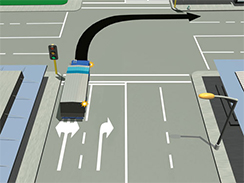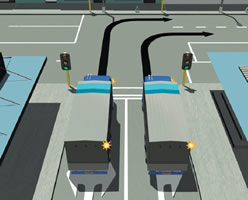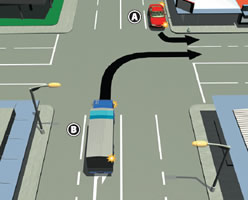Lanes are painted on the road to separate traffic. It’s important that you use lanes correctly.
Because of the size of your vehicle, you may not always be able to stay entirely in your own lane while making some driving manoeuvres. If this is the case, you must give way to vehicles in the other lane and drive carefully.
When turning right from a road that has more than one marked lane in each direction into another road with more than one marked lane in each direction:

Turning right with marked lanes
When turning right from a one-way street, you should stay in the same lane throughout the turn. That means:
Remember to signal for at least three seconds before turning.

Turning right from a one-way street
When two vehicles are turning into the same road at an intersection that has more than one marked lane in both directions:

Turning at a laned intersection
Safe turning tipIf you have stopped to turn right, keep your wheels pointed straight ahead until you start to turn. That way, if you are hit from behind you are less likely to be pushed into the path of oncoming traffic. |
Special vehicle lanes have signs or markings that indicate they are only for the use of specific kinds of vehicles, such as buses, cycles or vehicles carrying a specified number of passengers (transit lanes).
Examples of special vehicle lane signs
Other vehicles may use special vehicle lanes to make a turn or get to a parking space. Use of the lane for these purposes must be kept to a minimum length and be no more than 50 metres. You must give way to any vehicles entitled to use the lane.
Some special vehicle lanes operate 24 hours a day for the use of the designated vehicles. Others have times of operation specified on their signs, for example, ‘4pm to 6pm’. In that case, you may be able to park or stop in them outside of those times.
ImportantDo not drive your truck in cycle lanes. |